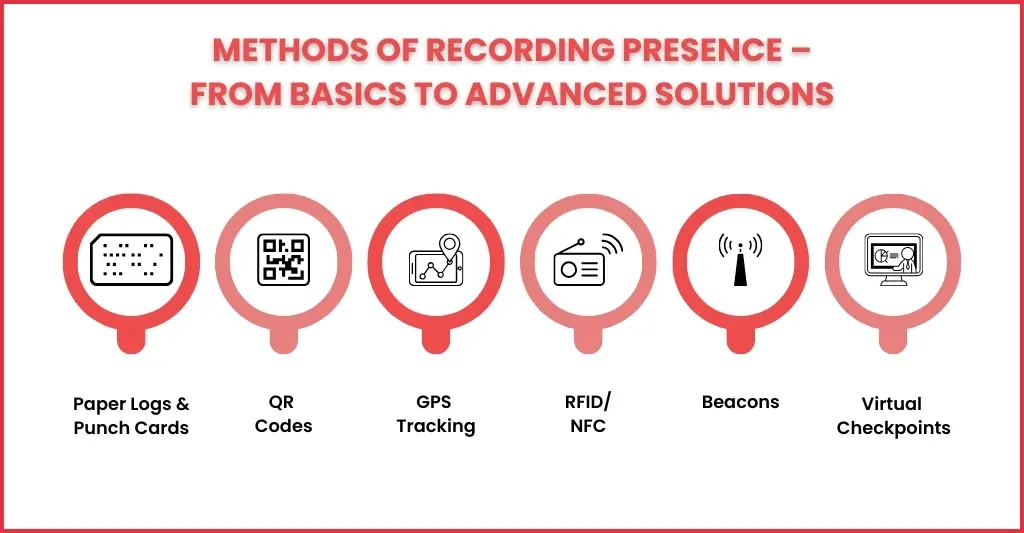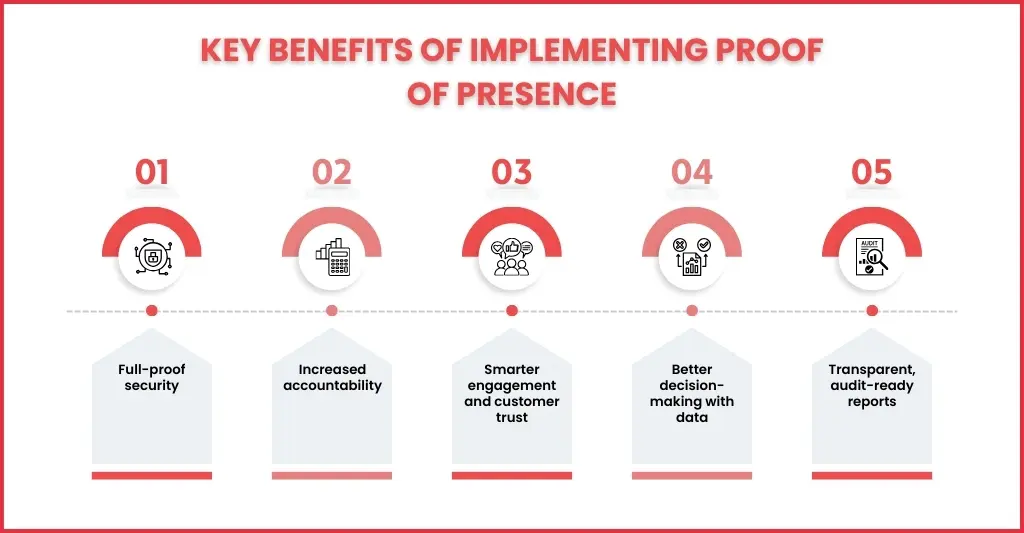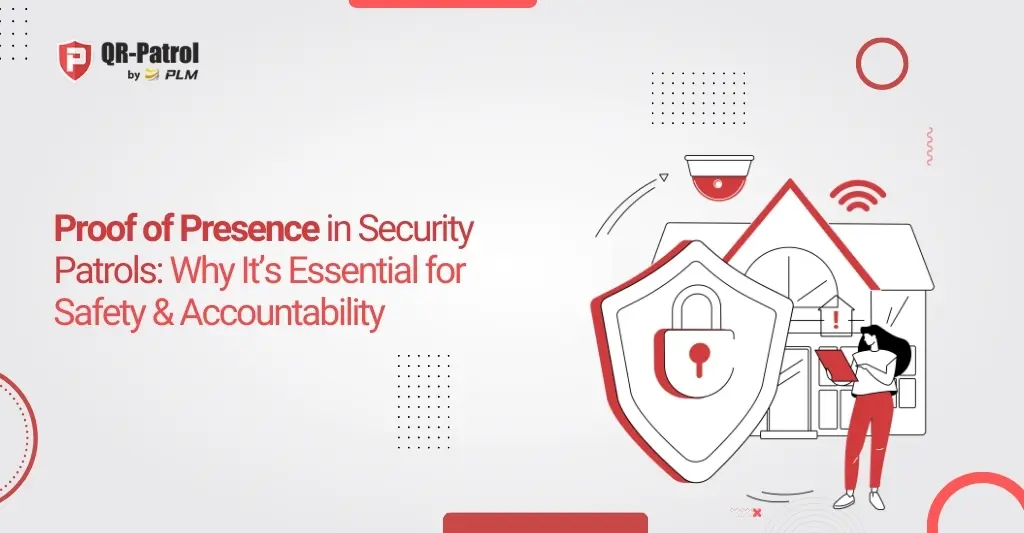Verifying the presence of personnel these days is becoming an essential but a difficult task due to frauds and tampering. The question that every organisation is grappling withis: how to verify a person’s presence in the office, on digital platforms, at events, and in workflows? Proof of presence will be the answer to this question.
Proof of presence is a verification method used by UK security firms to confirm a guard or employee is physically present at a specific location and time, preventing fraud and improving accountability.
In this blog, you will get to know about it in detail including its important, benefits, challenges, and future. Let’s delve into it.
What is Proof of Presence in Security Patrols?
Proof of presence is a method to confirm a person’s physical or digital presence at a specific place and time, and the record of the presence. It’s not just about logging into a system, but verifying that the actual person is present or not.
Under proof of presence, identity verification occurs. An identity can be hacked, shared or borrowed, but presence cannot. Proof of presence means confirming someone did, in the right place, at the right time.
Proof of presence is used in:
- Confirming login by authenticating the person behind the screen.
- Verifying that the workers are on-site and are not clocking remotely.
- Providing digital proof to attendees who have attended the session.
Why Proof of Presence is Important in Security Patrols?
Multiple reasons make proof of presence necessary for organisations based in the UK. These reasons are as follows:
Security
Passwords can be leaked or shared when access depends only on them, which can create a level of doubt. Proof of presence removes that doubt. By using biometrics, facial recognition, and behaviour-based marker systems, it can identify whether a real person acted or not. Proof of security is crucial in sensitive environments, such as financial transactions, access to sensitive data, or regulatory compliance.
Workforce Accountability
Companies involved in logistics, maintenance, and healthcare require employees to be on-site. However, manual check-ins and log-outs can be manipulated easily. Proof of presence confirms that a staff member has reached the location as scheduled, providing managers with assurance that the person responsible for completing the task has arrived. Also, proof of presence validates the work done, not just attendance.
Experience Validation
People want more than just an email; they want proof they were part of something. Blockchain-based PoP tokens are already being used at events, exhibitions, and webinars to record and reward attendance. These tokens are cryptographically verified, collected, and used to unlock future access or engagement opportunities. It turns presence into part of the user’s identity, a moment that’s verifiable and ownable.
Insights
A massive number of insights open up when it clients knows who showed up, when, and where. The proof of presence will help map the footfalls, and with real data in hand, guesswork stops, and real work begins. Based on the data, decisions can be made on solid grounds.
Methods of Recording Proof of Presence

There are multiple ways to record proof of presence, ranging from traditional methods to fully automated technology. Each has its own strengths and weaknesses, and you will need to determine which one is best suited for your clients. Let’s take a closer look:
Paper Logs
If you are providing security services for small start-ups or companies with a low employee count, then manually signing a logbook or checklist at each checkpoint is required.
- How it operates: Under this method, the guard will write the name, time and signature.
- Pros: It’s a no-investment and straightforward method, making it a low-cost option.
- Cons: However, it is prone to human errors and falsification.
- Ideal for: Yet, this method is particularly suitable for low-risk environments or temporary sites where the deployment of technology is impractical.
Punch Cards or Time Clocks
Fixed at the designated entry point, electronic clocks will enable employees to enter after they have punched in.
- How it operates: Under this, a card must be inserted or an ID must be logged in, which timestamps the visit.
- Pros: It is more reliable than paper logs and provides evidence of entry.
- Cons: However, there is no flexibility due to its fixed location, and it does not provide real-time updates.
- Ideal for: This method is particularly suitable where there is a fixed entry point, such as a warehouse or office building.
RFID/NFC Tags
Radio-frequency identification (RFID) or near-field communication (NFC) tags are placed at checkpoints and scanned by guards using handheld readers or smartphones.
- How it operates: Each tag has a unique ID, and when it’s scanned, it records the date, time, and presence.
- Pros: It’s a quicker, more accurate and tamper-proof method than manual ones.
- Cons: This method requires a security guard to carry a handheld device at all times, and any damage to the device would hinder its effectiveness.
- Ideal for: Such a method is useful for large and medium office sites where digital logs are needed without frequent need for real-time updates.
QR Codes
QR codes are the latest addition to methods of recording proof of presence, which can be scanned using a mobile app.
- How it operates: Every QR code is unique, and once scanned, the details are logged.
- Pros: It is low-cost (printing QR codes) and easy to deploy.
- Cons: To use it successfully, you will need a smartphone with a camera and an active internet connection to support real-time updates.
- Ideal for: It is a cost-effective and flexible solution with real-time capability.
GPS Tracking
The use of GPS devices to track movements in real-time is the latest addition to methods of proving presence.
- How it operates: It will help your security personnel in doing live tracking and verification of routes.
- Pros: It offers real-time visibility in large indoor sites or outdoor locations.
- Cons: Not ideal for small indoor offices with patchy mobile network coverage, and it raises concerns about privacy.
- Ideal for: Useful for large construction sites or offices where tracking and route coverage are important.
Beacon Technology (Bluetooth Beacons)
Another method of proof of presence is the use of Bluetooth beacons, which transmit signals to nearby devices to automatically detect them.
- How it operates: The security personnel will pick up the signal when a verified employee is within range, eliminating the need for a manual scan.
- Pros: It is hand-free, accurate, and has no chances of misses.
- Cons: Requires beacon installation and battery maintenance.
- Best suited for: The method is ideal in environments where physical contact must be kept to a minimum, such as healthcare facilities and medical laboratories.
Virtual Checkpoints (Geo-Fenced Digital Locations)
Virtual Checkpoints are QR-Patrol’s innovative feature that allows security teams to create checkpoints within a set range using GPS and mobile signals, without needing physical devices at the site.
- How it operates: Supervisors define a virtual area on the map, and once personnel enter that zone, their presence is automatically recorded. No physical installation is required.
- Pros: It offers flexibility, fast deployment, and is ideal for areas where setting up physical checkpoints is impractical. It also supports larger-scale operations with minimal hardware.
- Cons: Relies on mobile connectivity and precise location tracking; privacy considerations must be addressed.
- Ideal for: Perfect for monitoring patrols in expansive outdoor sites, temporary events, or restricted zones without installing physical devices.
Traditional vs. Modern Proof of Presence
Traditional and modern proof of presence systems support various types of patrol, such as routine, random, or incident-based patrols. While traditional methods rely on manual tracking, modern solutions offer automated and real-time monitoring to enhance patrol efficiency and accountability.
Traditional
Under traditional proof of presence, your security firm will need manual or static systems that require human intervention. It includes:
- Paper Logbooks
- Mechanical Time Clocks
- Wall-Mounted Readers
These systems are sound but have limitations, such as:
- Human Error: Handwritten logs could be forgotten, misread, or falsified.
- No Real-Time Oversight: Supervisors will not get real-time updates of people entering and leaving the office premises.
- Vulnerability to Tampering: Logs and punch cards could be manipulated.
- Administrative Burden: Managers had to manually collect, store, and review paper records, which added unnecessary workload.
Modern Proof of Presence
The modern proof of presence, such as cloud-based, mobile, and data-driven solutions, offers transparency and valuable insights. These systems are:
- Smart Phone Apps: QR codes, NFC tags, or record GPS checkpoints instantly.
- Cloud Synchronisation: Getting data in real-time so that live monitoring by security personnel can take place.
- Automated Alerts: Give automated alerts when personnel are late on duty.
- Digital Reports: All the data is compiled automatically in a proper and easy-to-understand format
The advantages for security firms are clear:
- Live Visibility: Real-time updates for supervisors enable them to intervene promptly when issues arise, thereby improving response times and overall efficiency.
- Accountability: Each action is timestamped and stored securely, ensuring tamper-proof records.
- Efficiency: No more paper reports, everything will be available with a single click.
- Confidence: They will get access to clean and verifiable data.
How QR-Patrol Provides Proof of Presence
QR-Patrol is the leader in cloud-based guard tour systems and it offers proof of presence system. This system is based on the use of NFC, Beacon and QR-code tags. QR-Patrol also introduced a new security feature called Virtual Checkpoint, which has its set range within which scans and other tasks can take place.
This groundbreaking feature is exclusive to our GOLD tier subscriptions, empowering clients with unmatched flexibility and efficiency. By removing the need for physical installations, Virtual Checkpoints allow rapid deployment, smarter patrol scheduling, and wider area coverage — all while maintaining the highest security standards. It’s a perfect solution for businesses requiring advanced monitoring without infrastructure constraints.
Through this system, QR-Patrol provides proof of presence in multiple ways, such as:
Real-time Notifications
One of the most significant plus points of QR-Patrol is the ability to alert in real-time through:
- Missed Patrol Alerts: When a guard does not reach a particular checkpoint within the specified time, an alert is sent to the supervisor.
- SOS & Panic Alerts: Guards can send an emergency signal if assistance is required, thus improving safety.
- Live Tracking: Supervisors can receive live location updates to ensure all security procedures are being followed.
This level of visibility enables security managers to act proactively, rather than only reviewing incidents after the fact.
Flexible Checkpoint Setup
Setting up this system is easy and scalable. The reason for this is:
- Quick Deployment: QR codes or beacons can be placed anywhere and at any place of your choice.
- Customise Schedules: Patrol frequency and route can be customised as per your clients’ requirements.
- Scalability: Adding new checkpoints will take a few minutes, making it ideal for multiple clients.
Incident Reporting in the Field
Not just scanning, QR-Patrol lets security personnel to go beyond that:
- Photo Evidence: Allows guards to attach images of any hazards directly to the app.
- Categories: They can also categorise the incident for fast action.
- Voice Recording: During emergencies, sending voice notes will be ideal instead of typing notes.
Secure Cloud Storage & Reporting
All the details are stored securely in the cloud. These data include:
- Audit-Ready Data: Historical logs are accessible at any time for audit purposes.
- Automatic Reports: Weekly reports will be sent directly to your clients, thus saving admin time.
- Tamper-Proof Records: All data will be timestamped and stored centrally, making it tamper-proof.
Integration with Other Systems
QR-Patrol can integrate with third-party platforms, such as incident management software or client portals, creating a single source of truth for security data and enhancing overall service delivery.
Benefits of Implementing Proof of Presence Systems

Proof of presence systems are gaining ground among security establishments in the UK due to their tangible benefits. These benefits are:
Full Proof Security
Gaps that exist in passwords, swipe cards, and logins will be closed by proof of presence. It will always confirm that the person is real and not a bot.
Pure Accountability
The data on entry and exit will be available, reviewable, auditable, and trustworthy. It helps reduce disputes and brings clarity to incidents and schedules.
Smarter Engagement
In a customer-facing environment, proof of presence helps in understanding behaviour patterns, making it easy to personalise.
Better Decisions, Backed by Accurate Data
When personnel are aware that their presence is being monitored, their productivity tends to improve. There will be a clear understanding of the tasks without any guesswork.
Maintaining Digital Records
Proof of presence records can be stored and shared for future experience, thus creating trust and engagement.
Challenges and Considerations
While proof of presence systems is attractive due to the security and accountability they offer, they come with their drawbacks in the form of challenges. These challenges must be taken into consideration so that measures can be taken to overcome them.
- Cost of Setup: For many of your clients, the proof of presence systems will be new and will require initial investments in training and familiarisation. Additionally, to account for the costs of acquiring machines, software, and installation charges.
- Depended on Machines: Without smartphones, scanners, or beacons, the proof of presence systems cannot operate, leaving you handicapped in the event of a machine malfunction.
- Connectivity Issues: Connectivity issues may arise when the system is used in indoor areas or remote rural locations.
- Data Security: All the data must be stored in a location that complies with UK GDPR.
Best Practices for Implementing Proof of Presence
To stay one step ahead of your competitors, it is essential to get hands-on with the proof of presence system. For that, you will need to implement certain best practices.
- Proper Training: Train the guards on how to operate the system and explain its purpose and functionality. Live training will be ideal.
- Preference for High-Risk Sites: Introduce this system where it is required most, such as a warehouse or hospital, where accountability is crucial.
- Regular Audit of Data: Make it a point to audit the data gathered by the system to identify gaps and suggest measures to rectify them.
- Tech Updating: Ensure that all devices, software, and tags are updated and functioning correctly to avoid errors during live situations.
- Regular Communication with Clients: Ensure that you share the reports generated with your clients to foster trust.
Future Trends in Proof of Presence Technology
Initially, the proof of technology was limited to check-ins and sign-ins, but it is now evolving into something more advanced. The focus will be on precision, automation, and identity that can’t be duplicated.
Emphasis will be placed on work validation, under which your clients would like to know what work was done, apart from who came in. The system will be expected to store task data, completion logs, and quality checks to build a more complete picture.
Focus is also shifting from centralised databases to store identities toward decentralised identities, which will be stored in digital wallets. It gives users control, and organisations better trust in the data they receive.
Lastly, AI is having an impact on the presence detection system tool. Systems are started analysing behaviour patterns and not just entries. These patterns will be analysed and recorded in real-time.
FAQs: Frequently Asked Questions
Is Proof of Presence legally required?
Not always, but many clients require it as part of their service agreement, and insurers often encourage it for risk management purposes.
Can Proof of Presence work offline?
Yes, many systems store data offline and sync when internet connectivity is restored.
How secure is the data collected?
Reputable systems, such as QR-Patrol, utilise encrypted storage and comply with GDPR requirements to safeguard sensitive data.
Is GPS tracking enough for Proof of Presence?
GPS is helpful but not always precise indoors. Combining it with QR or NFC scanning ensures accuracy.
Conclusion
Proof of presence is becoming a valuable asset for UK security companies, particularly when it comes to offering accountability at entry and exit points for clients. With the proof of presence system in your hands, you will be able to ensure a safe environment for both indoor and outdoor working locations, regardless of their size. It helps in building trust, improving compliance, and delivering a safe environment for your clients and guards.
Do you need a sophisticated security system like this? QR-Patrol is here to assist you. We are well-positioned to offer cutting-edge security solutions and provide training to your staff. We ensure transparency and real-time updates, and Proof of Presence is at the heart of it.


